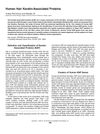TLDR Curly hair shape is due to uneven growth patterns in the hair follicle.
The study investigated the structural elements related to hair curl patterns by examining human hair samples ranging from straight to tightly curled. It found that the frequency and amplitude of cross-sectional rotations were crucial for describing curliness at the macroscopic level. Transmission electron microscopy revealed that macrofibril organization was strongly related to hair curliness, with curly hair follicles exhibiting retrocurvature regardless of ethnic origin. The study highlighted an intrinsic asymmetry in the proliferative compartment of curly hair, causing delayed differentiation of inner and outer root sheaths and resulting in an elliptical and asymmetric hair cortex. The accumulation of hHa8 keratin on the concave side of curly hair, as opposed to the even distribution in straight hair, suggested that the curly shape of the hair shaft resulted from asymmetric differentiation of the precortex, making hair fiber a shape memory material.
122 citations
,
January 2006 in “Molecular & Cellular Proteomics” Human hair contains many proteins, with some being highly abundant and modified.
226 citations
,
January 2006 in “International review of cytology” Keratin-associated proteins are crucial for hair strength and structure.
29 citations
,
April 2003 in “Experimental dermatology” Human hair follicles grown in vitro maintain normal keratin patterns and structure.
272 citations
,
September 2001 in “Journal of Biological Chemistry” Human hair keratins were cataloged, showing their roles in hair differentiation stages.
235 citations
,
July 1999 in “Journal of biological chemistry/The Journal of biological chemistry” Human hair is made up of different keratins, some strong and some weak, with specific types appearing at various stages of hair growth.
252 citations
,
January 1991 in “Electron Microscopy Reviews”
22 citations
,
January 2020 in “PeerJ” Keratin peptides in hair might help identify gender and ethnicity.
55 citations
,
January 2013 in “International Journal of Cosmetic Science” African hair's keratin structure is influenced by its higher lipid content.
50 citations
,
July 2008 in “British Journal of Dermatology” 138 citations
,
March 2007 in “Experimental cell research” Only a few hair-specific keratins are linked to inherited hair disorders.
 71 citations
,
August 2005 in “The journal of investigative dermatology. Symposium proceedings/The Journal of investigative dermatology symposium proceedings”
71 citations
,
August 2005 in “The journal of investigative dermatology. Symposium proceedings/The Journal of investigative dermatology symposium proceedings” Hair keratin-associated proteins are essential for strong hair, with over 80 genes showing specific patterns and variations among people.
276 citations
,
January 2005 in “International review of cytology” More research is needed to understand how hair keratins work and their role in hair disorders.
 199 citations
,
January 2004 in “The International Journal of Developmental Biology”
199 citations
,
January 2004 in “The International Journal of Developmental Biology” Hair follicle growth and development are controlled by specific genes and molecular signals.
29 citations
,
April 2003 in “Experimental dermatology” Human hair follicles grown in vitro maintain normal keratin patterns and structure.

